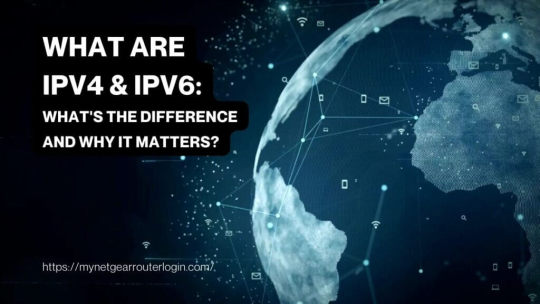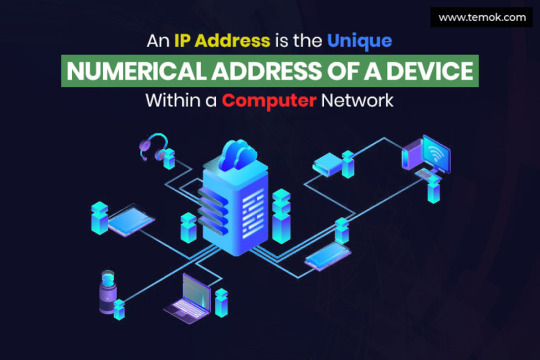#ipv4vsipv6
Explore tagged Tumblr posts
Text
What is an IP address

What is an IP address?
IP (internet protocol) is the protocol by which is sent data from one computer to another device on the internet. Each computer on the internet has different IP address identify it from all other computers on the internet. An IP address is a numeric address and identifier for a computer or device on a network. Every device has and has an IP address for communication purposes. The IP address consists of 2 parts. The first part is the network address and the second part is the host address. There also two types of IP addresses the first one is the most common one is called IP version 4 (IPv4) and a second type is IP version 6 (IPv6)
Internet protocol version 4 (IPv4)
Internet protocol version 4 (IPv4) is the fourth version of the internet protocol (IP). This protocol most used today in data communications over different kinds of the network because it supports all devices.IPv4 invented in 1970. Is IP version 6 4 is the current version (not for long) of IP addresses. 32-bit numeric address written as four numbers separated by periods (55.68.236.15).

This Picture created by Kironmoy Roy Each group of numbers that are separated by period is called in architect. The number range in chartered is equal 0 to 255. This address bro Shankar produced over probably 4.3 billion unique addresses.
Internet protocol version 6 (IPv6)
Internet protocol version 6 (IPv6) It is the most recent update version protocol of the internet. That provides an identification and location system for computers and routes traffic across the internet. IPv6 invented in 1998. On the internet first developed a program that realizes have big would become. They thought IP version 4 Which produced over 4 billion addresses would be enough, but they were wrong. IP version 6 is the next generation of IP addresses. The main difference between IP version 4 and IP version 6 is the link to the address. The IP version 4 address is its 32-bit numeric address. Where is IP version 6 is a 128-bit hexadecimal address? Hexadecimal uses both numbers and alphabets in the address.

This Picture created by Kironmoy Roy So with this type of address, IP version 6 can produce an unbelievable 340 and 10 Alien IP addresses does the number 340 with 36 digits afterward guest IP version sex is more than enough for the foreseeable future. So study before IP version 6 is a hundred and twenty-eight (128) bit hexadecimal address. It is made up of 8 sets of 16 bits. With 8 sides are separated by Collins.
DIFFERENCE BETWEEN IPv4 VS IPv6

This Picture created by Kironmoy Roy IPv4 IPv6 1.IPv4 is a 32-bit address. 1.IPv6 IS 128-bit address. 2.IPv4 is the numbering address method. 2.IPv6 is the alphanumeric address method. 3.IPv4 binary bits are separate by dot(.) 3.IPv6 binary bits are separate by a colon(:). 4.IPv4 has a different 5 class of IP addresses. Class A, Class B, Class C, Class D, Class E 4.IPv6 does not have any different types of IP addresses. 5.IPv4 has a limited number of IP addresses. 5.IPv6 has an unlimited number of IP addresses. 6. An example of an IPvs4 address is 357. 169.05 34. 6.Example of IPv6 address is F3oo:89A9:ABCF:7987:AB84:G00T:9874:VWXY. 7.IPvp4 has 12 numbers of header filed. 7.IPv6 has 8 number of header filed. 8.IPv4 length of the header filed is 20-60. 8.IPv6 length of the header filed is 4o. 9.IPv4 has availableChechecksum field. 9.IPv6 has not available any Chechecksum field. 10.IPv4 pocket size is 576 bytes. 10.IPv6 pocket size is 1280 bytes. 11.IPv4 has an available optional filed. 11.IPv6 has not available an optional filed. 12.IPv4 is less secured. 12.IPv6 is more than required compared to IPv4. 13.IP sec support is optional in IPv4. 13.IP sec support is required in IPv6. 14.IPv4 uses both multicast and broadcast m passage transformation scheme. 14.IPv6 doesn't use broadcast uses a different type of multicast massage transformation scheme. 15.IPv4 supports VLSM (Virtual Length Subnet Mask). 15.IPv6 doesn't support VLSM. IPv4 and IPV6are applied to identify a device connected to a network. I principle, they are similar but they are various in how they work. IPv4 and IPv6 are cannot communicate with other network but it can exist together on a similar network. This is called Dual Stack. What Is HTTPS and Why Should I Care? Read the full article
#differencebetweenipv4andipv6geeksforgeeks#differencebetweenipv4andipv6incomputernetwork#differencebetweenipv4andipv6pdf#differencebetweenipv4vsipv6#ipv4fullform#IPv4invented#ipv4vsipv6#IPv6invented#whatisanipaddressdefinition#whatisanipaddressquora#whatisanipaddressusedfor
1 note
·
View note
Text
What are IPv4 and IPv6 and What's the Difference Between IPv4 vs IPv6?

Concerning network communication, the proper mode of communication is none other than the Internet Protocol (IP). This protocol contains unique numeric identifiers, which greatly assist in handling communication by helping identify devices on the World Wide Web. These numeric identifiers are also addressed as IP addresses and come in two types: IPv4 and IPv6. Historically speaking, most people have routinely utilized Internet Protocol version 4 or simply IPv4 when it comes to internet address schemes. Nevertheless, due to the rapid expansion of internet-connected devices, IPv4 addresses have become scarce. IPv4 has limitations in its address capacity, which prompted the invention of a newer variant known as Internet Protocol version 6 or simply IPv6. Unlike its predecessor, which operates on small-scale addressing techniques, IPv6 offers a more comprehensive range of identifiers. This article will differentiate these two protocols and discuss why adopting IPv6 is critical to the future of the internet.
What is IPv4 Address?
An IPV4(Internet Protocol version 4) address is a numerical label assigned to any device connected to the internet, including laptops or smartphones, printers, and even gaming consoles. It's essential because it enables these devices to communicate effectively with others on the network - without confusion! The address format consists of four sets of numbers separated by periods - called octets - each ranging from zero to two hundred fifty-five (0-255). For example, 192.168.0.1 shows an IPV4 address used worldwide as a private IP number series.
What is IPv6 Address?
An IPv6(Internet Protocol version 6) address is 128-bit in eight hexadecimal groups separated by colons. For example, 2001:0db8:85a3:0000:0000:8a2e:0370:7334 is an IPv6 address. The 128-bit address space provides approximately 3.4×10^38 unique addresses, a significantly larger address space than IPv4.
How to find IPv6 address?
To find the IPv6 address on a Windows computer? For all those who need help figuring out their IPv6 address in a Windows environment, look no further than these easy-to-follow instructions! - Begin with opening up the Start menu using both the Windows key + X keys simultaneously; - Once inside its contents list, select "Network Connections." - Next comes finding your existing Network Adapter - upon discovery, perform a right-click followed by accessing "Properties." - Continuing to locate a specific section titled "Internet Protocol Version 6 (TCP/IPv6)". Then click the "Properties" button. - This section will then provide access to their IPV6 details, such as whether they were automatically assigned one or if they had manually requested one themselves.
What's the Difference Between IPv4 and IPv6?
Internet Protocol (IP), being the foundation for all online communication, plays a vital role in enabling devices connected across networks to share and send information seamlessly. It allows identification within each system using assigned IP addresses that allow data packet transmissions between them. Amidst escalating numbers of interconnected units that require exclusive identification on the Internet, IPv4 is becoming increasingly limited in its ability to assign unique addresses. This is where IPv6 comes in. The article was referenced from https://mynetgearrouterlogin.com/what-are-ipv4-and-ipv6-ipv4-vs-ipv6/ Read the full article
0 notes
Link
It is always good to review your present business model and goals, does your business will need to convert IPv4 to IPv6? Are you venturing into Internet of Things or are into gadgetry that only works on IPv6? then acquiring IPv6 must be on your priority list. But what happens to your existing IPv4s? This is where you need an IPv4 exchange platform like IPv4.deals (by Alpha InfoLab) that makes sure you are connected with a genuine buyer and get a fair IP price for your IPv4s
0 notes
Link

As we know the Internet of Things (IoT) keeps on developing exponentially, more gadgets associate online day by day. There has been dread that, sooner or later, IP locations would simply run out. This guess is beginning to work out as expected.
Read More: http://bit.ly/ipv4vsipv6
0 notes